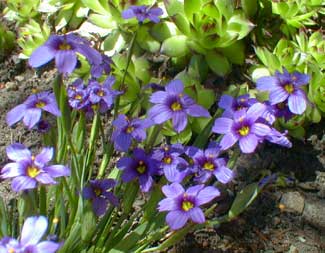
'E. K. Balls' aka
Balls' Mauve Blue-eyed Grass
"Through the blue shadowy valley
I hastened in a dream:
Flower rich the night,
flower soft the air,
a blue flower the stream."
-George William ("A. E.") Russell
(1867-1935).
(1867-1935).
Sisyrinchium x bellum 'E. K. Balls' aka 'Balls' Mauve' is a hybrid blue-eyed grass. The genus consists of primitive irises with many species, all native to the Americas.
This cultivated form is named for a British botanist & plant-explorer, Edward K. Balls, who collected plants in the American west & wrote Early Uses of California Plants (1962).
This is the Western or California Blue-eyed Grass, S. bellum, possibly but not certainly hybridized with Idaho Blue-eyed grass, S. idahoense var macounii, a variant found only in Washington state.
It is shorter & more compact than most blue-eyed grasses, its miniature gladiola-like fanning foliage rising to a mere five or eight inches height.
The flowers are a particularly deep blue, on short stems slightly above the dwarf foliage. It is unusually floriferous in May & June, with occasional rebloom up to autumn.
It is no use taking the blooms for bouquets, as individual blooms are quite ephermal, though the clump is very flowery because it produces such a great many buds that open serially.
Prairie conditions or rock-gardens suits 'E. K. Balls' very well. It wants full sun & will not do well without it. It's suited to USDA zones 4 through 8, & wants moderate watering in well-draining soil. Although it is seasonally drought-tolerant, its method of dealing with drought is to go dormant, whereas well-timed & occasional watering will keep it reflowering until autumn.
It does not seem to self-seed like most blue-eyed grasses so is either a sterile hybrid or has a very low germination rate for the seeds. But it can be quite a vigorous clump & if it likes its location it'll need to be dug up & divided about every three or four years, or more often for propagation purposes.
The grass strives to be evergreen through winter but is usually pretty far gone by the time spring regrowth begins.